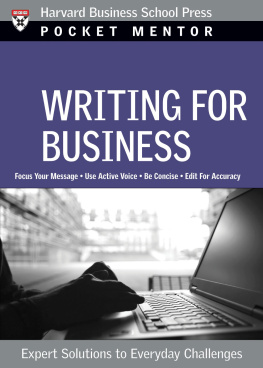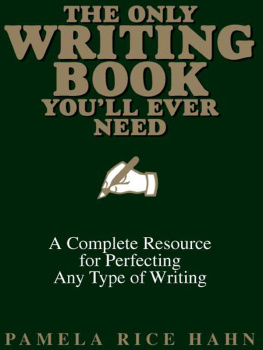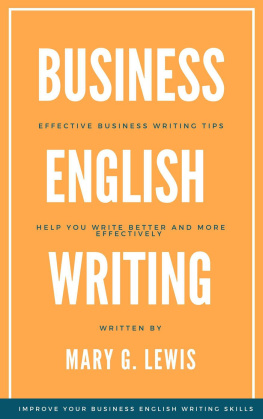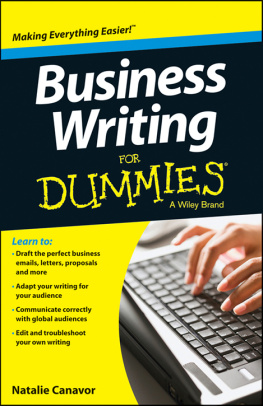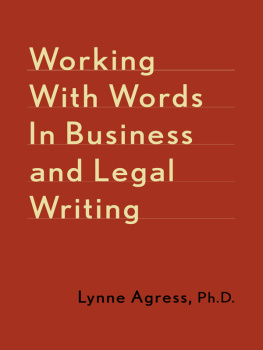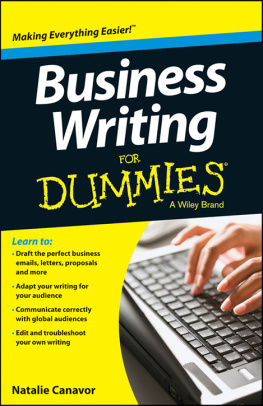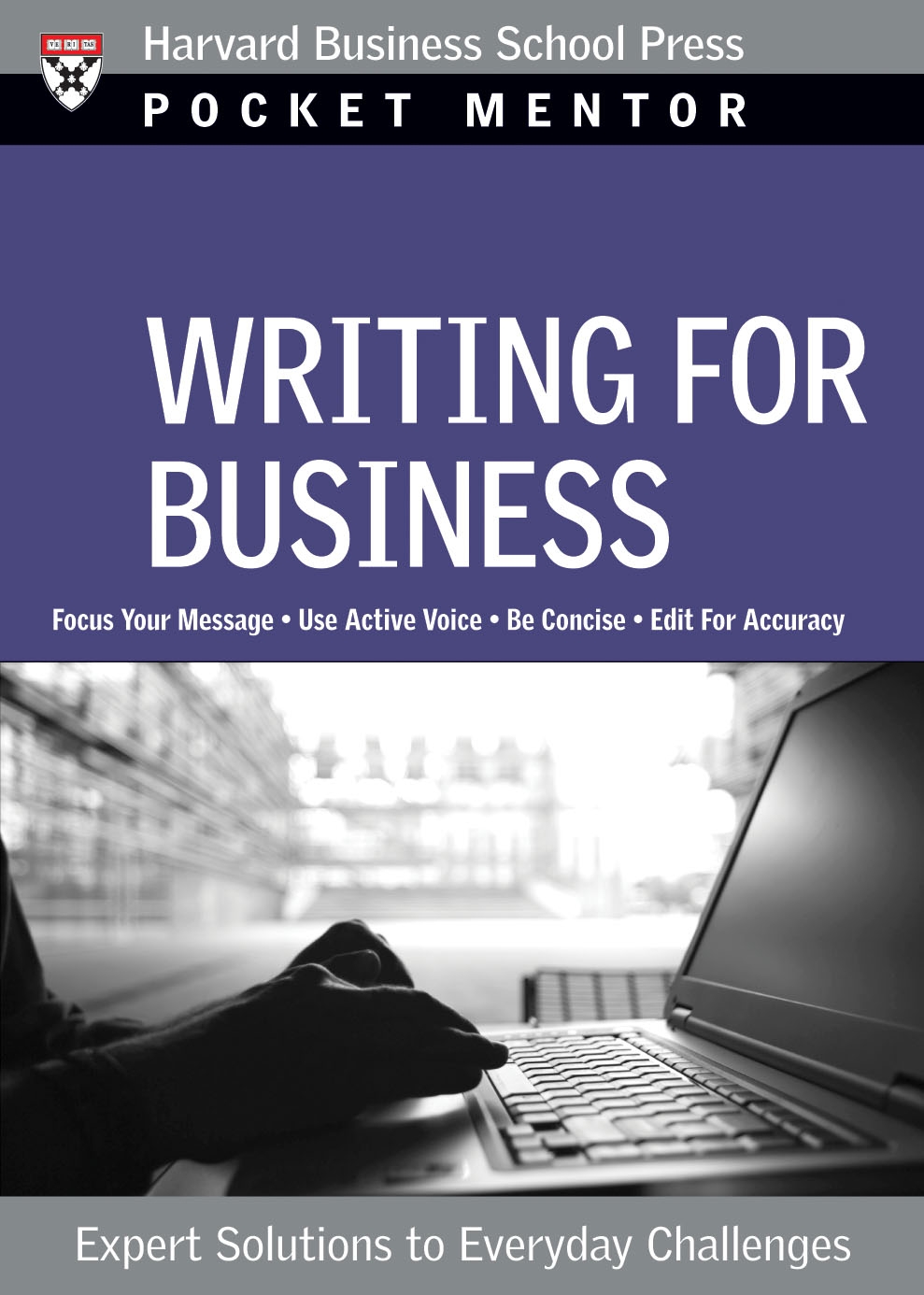Pocket Mentor Series
The Pocket Mentor Series offers immediate solutions to common challenges managers face on the job every day. Each book in the series is packed with handy tools, self-tests, and real-life examples to help you identify your strengths and weaknesses and hone critical skills. Whether youre at your desk, in a meeting, or on the road, these portable guides enable you to tackle the daily demands of your work with greater speed, savvy, and effectiveness.
Books in the series:
Leading Teams
Running Meetings
Managing Time
Managing Projects
Coaching People
Giving Feedback
Leading People
Negotiating Outcomes
Writing for Business
Giving Presentations
Writing for Business
Expert Solutions to Everyday Challenges
Harvard Business Review Press
Copyright 2007 Harvard Business School Publishing Corporation
All rights reserved
Printed in the United States of America
11 10 09 08 07 5 4 3 2 1
No part of this publication may be reproduced, stored in or introduced into a retrieval system, or transmitted, in any form, or by any means (electronic, mechanical, photocopying, recording, or otherwise), without the prior permission of the publisher. Requests for permission should be directed to permissions@hbsp.harvard.edu, or mailed to Permissions, Harvard Business School Publishing, 60 Harvard Way, Boston, Massachusetts 02163.
Library of Congress Cataloging-in-Publication Data
Writing for business : expert solutions to everyday challenges. p. cm.(Pocket mentor series)
Includes bibliographical references.
9781422163771
1. Business writing. I. Harvard Business School Publishing
Corporation.
HF5718.3.W745 2007
808.06665dc22
2007000877
The paper used in this publication meets the requirements of the American National Standard for Permanence of Paper for Publications and Documents in Libraries and Archives Z39.48-1992
Mentors Message: Reader-Focused Writing Gets Results
To be successful, businesspeople need to use the latest and best strategies. This Pocket Mentor will update you on effective processes for writing everything from a simple memo to a proposal. Youll see how putting readers needs first can help clarify (streamline) your writing and extend your influence as a manager. This book contains easy-to-follow steps on how to
- Organize your documents to target your readers needs
- Jump-start your writing assignments to overcome procrastination
- Apply editing and design principles to drive action and decisions
When you apply these proven strategies, youll see the results in your writing productivity and document quality. In fact, your readers will comment on the difference!
Best of luck!
Deborah Dumaine, Mentor
Deborah Dumaine is the president and founder of Better Communications, a learning company that delivers globally recognized business, leadership, technical, financial, and sales writing workshops. Since 1978, nearly 100,000 learners have attended Better Communications workshops. Ms. Dumaine is the author of Write to the Top: Writing for Corporate Success (Random House) and the Instant-Answer Guide to Business Writing (iUniverse). She also has contributed sections on business writing to the World Book Encyclopedia . Ms. Dumaine holds BA and MA degrees from Smith College. For further information, please see her Web site at www.writetothetop.com .
Writing f or Business: The Basics
Foundation Principles
The difficulty is not to affect your reader, but to affect him precisely as you wish.
Robert Louis Stevenson
E FFECTIVE BUSINESS WRITING rests on a few foundation principles. If you master them, youll know how to handle the many different writing tasks that come your way.
Clarify your purpose
When you set out to write a business document, the first thing you should ask yourself is, Why am I writing this document? Business writing serves many purposes.
- Explain or justify actions: Because all of the bids we received from our current vendors were high, we decided to reject them and seek others.
- Convey information: Management wants all employees to know that quarterly sales of our new product exceeded expectations.
- Influence readers: The engineering team can meet these deadlines.
- Deliver good or bad news: Unfortunately, the engine fire you reported occurred one day after the expiration of the warranty.
- Request action: The design team should complete and deliver all product specifications by May 1.
Keep your purpose in mind as you begin writing. Many writers, in attending to the mundane tasks of preparing a document, lose track of their purpose. Heres one way to avoid that problem: jot down your purpose at the beginning of your draft, and refer to it as you proceed. When youve finished your draft, review it to make sure it fulfills your initial purpose.
Take a reader-centered approach
Just as a company wont connect with its customers if it fails to consider their needs and attitudes, you wont connect with readers if you dont understand them, their desires, and the way they prefer to receive information.
Thinking, drafting, organizing, and editing from your readers point of view improves clarity and drives action. If readers understand what you are trying to convey and what their next steps should be, their jobs will be much easier.
Why is a reader-centered approach important? Consider the true story of a company that failed to analyze its audience when writing what seemed to be a simple postcard announcing a change of address. Neglecting to put itself in its readers shoes, the company forgot to include one of the most vital pieces of information: the date of the move. Customers knew where to reach the company, but not when they should use the new address.
What Would YOU Do?
Attention Span
R OGER HAS TO SEND a memo to the field sales staff explaining the departments planned rollout of its spring catalog, which will describe all new and existing products. He wants to alert the staff to the time of the catalogs completion and delivery, and he wants to remind them to submit the names and mailing addresses of all the customers who should receive it. Hes in a quandary about how to structure his memo.
He could begin with a paragraph on the purpose of the catalog and then describe some of its high points or features. Eventually, hed want to remind his readers about sending in all customer addresses by February 15. It will probably take me half a page or so to say all of this, he thinks. I wonder how much of it theyll actually read? What would you do if you were in Rogers shoes?
State your key message clearly
Once you identify the purpose of your document and have considered your audience, isolate the key message you want your readers to remember. This message should be clear and conciseusually stated in only one or two sentences. For example, To meet our customers delivery deadline, we must complete the product design by May 1.
In many cases, your key message will be stated at or near the very beginning of the document; the rest of the document will be used to flesh out the details and to answer the question Why? or What are the implications of what I am proposing?

